Recent Articles
Popular Makes
Body Types
2024 Mazda CX-90 PHEV vs. 2024 Toyota Grand Highlander Hybrid
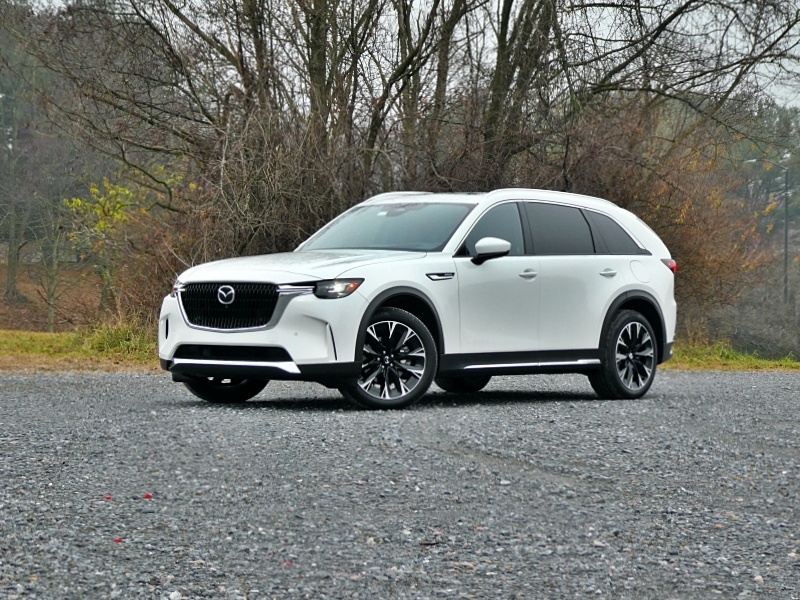
2024 Mazda CX-90 PHEV ・ Photo by Brady Holt
For three-row fuel efficiency, the Toyota Highlander Hybrid has been a go-to choice for years. But the 2024 model year brings two brand-new options for cutting your family’s fuel bill.
First is the gas-electric version of the new plus-size 2024 Toyota Grand Highlander, another three-row crossover SUV. It aims to resolve complaints that the standard Highlander is half a size smaller than many leading rivals. Next is the all-new 2024 Mazda CX-90, which replaces the CX-9 and comes with a plug-in hybrid version for the first time. For this review, we’ve spent a week testing both the Mazda CX-90 PHEV and the Toyota Grand Highlander Hybrid. We’ve compared them in eight different categories, then named an overall winner. Keep reading to see which SUV hybrid we picked and figure out which is the best for you.
Fuel Efficiency
The Grand Highlander Hybrid and CX-90 PHEV take two different approaches to fuel savings. The Toyota is a traditional hybrid: Electric motors work with the gasoline engine to help move the car without burning extra fuel, and the engine helps recharge the battery while you drive. Entry-level Grand Highlanders achieve an EPA-estimated 37 mpg in the city, 34 mpg on the highway, and 36 mpg combined in front-wheel drive and about 2 mpg less with all-wheel drive – incredible numbers for a big, roomy crossover. Upper-trim models use a more powerful turbocharged engine called the Hybrid Max and drop to a still-respectable 26 mpg city, 27 mpg highway, and 27 mpg combined; our Hybrid Max test vehicle averaged 28 mpg during a week of mixed driving.
The CX-90 PHEV, meanwhile, is a plug-in hybrid. That means you can charge its bigger battery using electricity from the grid, letting you use it as a fully electric vehicle on short trips. The EPA only estimates that it will get 25 mpg in mixed driving without plugging it in (we averaged 27 mpg), but your first 25 miles won’t burn a single drop of gas if you aren’t accelerating hard. One issue, which we read about a few owners experiencing as well: Our CX-90 PHEV persistently tripped the outdoor GCMI outlet where we normally charge vehicles at home. As of this writing, we haven’t gotten an answer from Mazda about whether this was a fault with the specific test vehicle or if all CX-90 PHEVs are more sensitive than other plug-in vehicles. Overall, we’ll call this category a tie – the Mazda is more efficient if you plug it in and take short drives, but the Toyota uses less gas on long drives without requiring a place to plug it in.
Winner: Tie
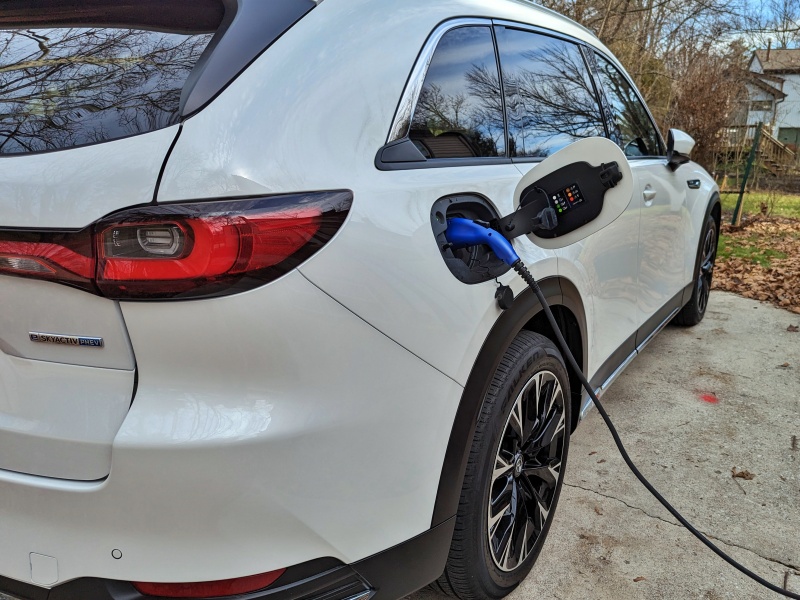
2024 Mazda CX-90 PHEV ・ Photo by Brady Holt
Pricing and Features
The 2024 Toyota Grand Highlander Hybrid starts at $44,670 versus $47,445 for the 2024 Mazda CX-90 PHEV. But the Toyota’s advantage isn’t all it seems.
The CX-90 has a lot of extra standard equipment that costs extra on the Grand Highlander: all-wheel drive, a sunroof, genuine leather upholstery (versus the Toyota’s leatherette), and an eight-speaker stereo (versus six speakers in the Toyota). Also, if you’re interested in both speed and efficiency, the Highlander Hybrid Max starts at $54,040, while even the base CX-90 PHEV delivers potent performance. Another factor is that, anecdotally, we’ve heard of buyers paying bigger premiums over the sticker price for the Grand Highlander. So despite the Toyota’s lower starting price, we’ll call this category another tie – the winner will depend on which features you’re interested in paying for and how good of a deal you’re able to score.
Winner: Tie
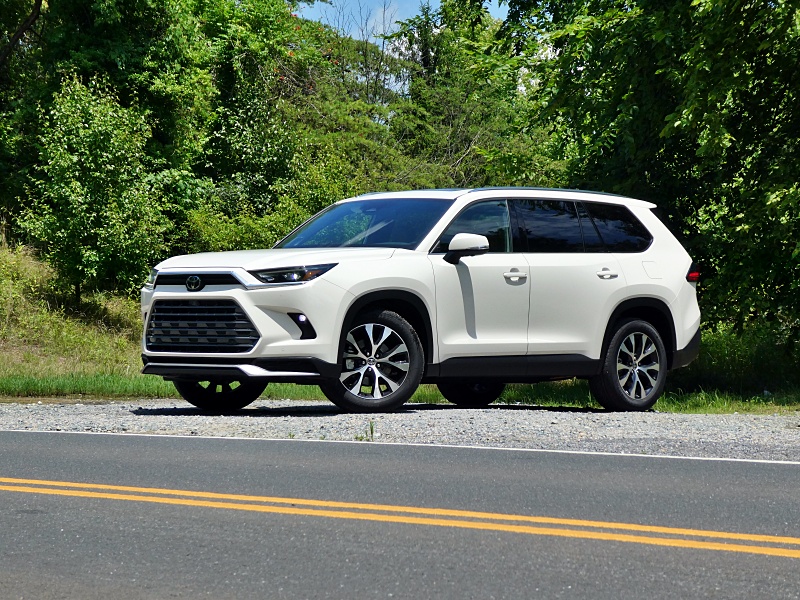
2024 Toyota Grand Highlander Hybrid Max ・ Photo by Brady Holt
Exterior Design
Both our CX-90 PHEV and our Grand Highlander Hybrid test vehicles were three-row crossover SUVs painted white. But that’s where their visual similarities end.
The Grand Highlander borrows its boxy shape from the smaller Toyota RAV4. Crisp, straight lines make it handsome, with the upright, confident look of a traditional SUV. The CX-90, meanwhile, wears the long nose and short front overhang of a luxury car – courtesy of the vehicle’s rear-wheel-drive roots. It’s elegantly swoopy rather than all-business functional and tough. Neither the Toyota nor the Mazda hybrid is visually distinct from its gas-only counterpart except for subtle badges, plus the fact that the CX-90 PHEV has fuel doors on each rear fender (driver’s side for gasoline, passenger’s side for electricity). Styling is subjective, and we’ll defer to individual tastes with yet another tie.
Winner: Tie
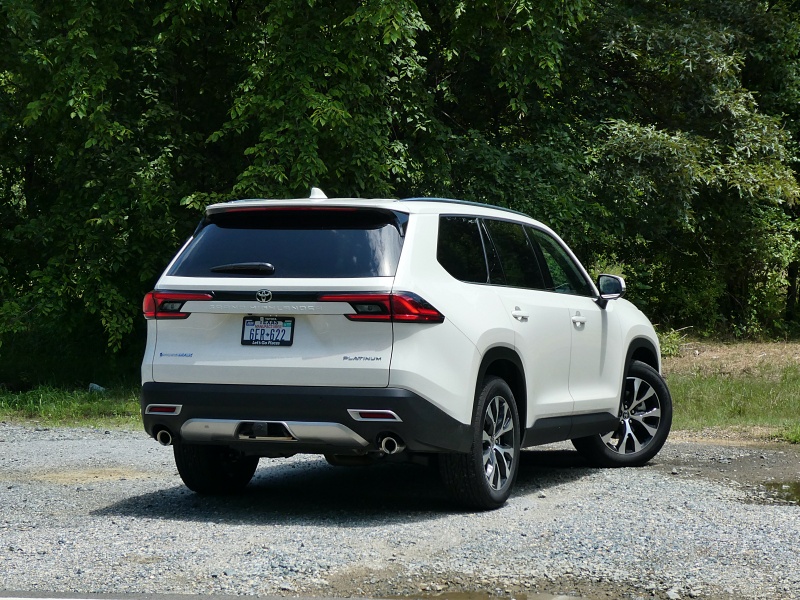
2024 Toyota Grand Highlander Hybrid Max ・ Photo by Brady Holt
Interior Design
When it comes to the interiors, we’re ready to declare our first winner, and it’s (narrowly) the 2024 Toyota Grand Highlander Hybrid. Once again, the Toyota and Mazda do things differently. The Grand Highlander’s interior is simple and functional. A big 12.3-inch infotainment touchscreen sits at the center of the dashboard, with a volume knob to its left and a cluster of physical climate controls below it. The interior is well-finished, though its “Grand”-ness is more due to size than splendid opulence. We appreciated our top-trim Platinum model’s rich leather upholstery on the seats and dashboard.
But Mazda goes all-out for luxury, with stunning materials and a sporty, minimalistic dash design. Moving parts like turn-signal stalks move with uncommon precision. But the Mazda comes up short for functionality. Its infotainment screen – 10.25 inches on base models, 12.3 inches on upper trim levels like our test vehicle – must usually be operated via a clunky control wheel between the seats rather than simple touch controls. (The bigger screen allows touch-based controls, but only if you’re using Apple CarPlay or Android Auto.) The CX-90 also has limited cabin storage for a three-row SUV. While we don’t love the Toyota’s infotainment system either, we think the Grand Highlander’s overall functionality trumps the CX-90’s “wow” factor.
Winner: Toyota Grand Highlander Hybrid
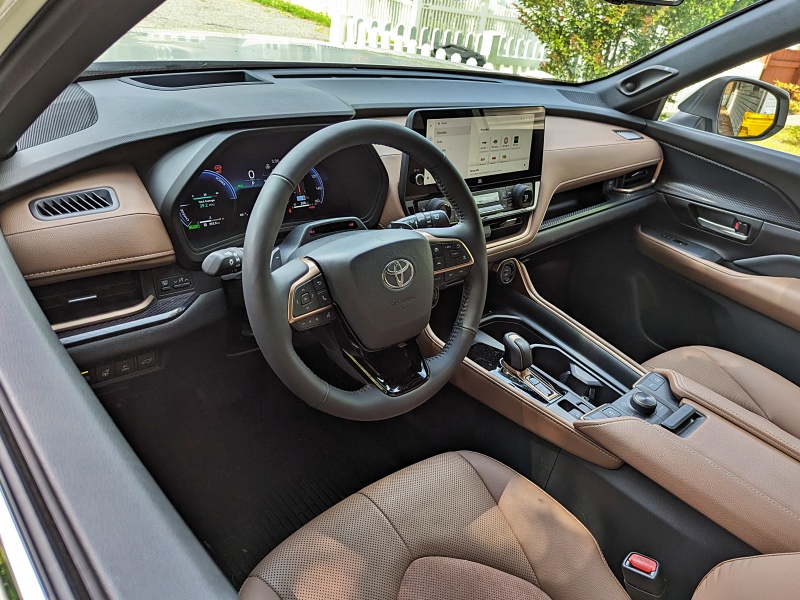
2024 Toyota Grand Highlander Hybrid Max ・ Photo by Brady Holt
Passenger Accommodations
Once again, the Grand Highlander Hybrid puts function first to come out ahead. Its boxy body and short nose make excellent use of its footprint to provide space for up to eight passengers. (Available second-row captain’s chairs drop the total capacity to seven.) The front and second-row seats have ample room, and even the third row can fit adults with less squeezing than the SUV norm.
The CX-90 can also wedge in up to eight people (or seven with second-row captain's chairs), but less comfortably. It’s a usable family vehicle, but there’s less legroom and hip space to go around than in the big Toyota. And even the front seats feel more cozy than airy. We appreciate how Mazda, like Toyota, provides second-row window shades as standard equipment; they’re a valuable amenity to protect young eyes from the sun. But the CX-90 doesn’t keep up with the Grand Highlander’s utility-focused spaciousness.
Winner: Toyota Grand Highlander Hybrid
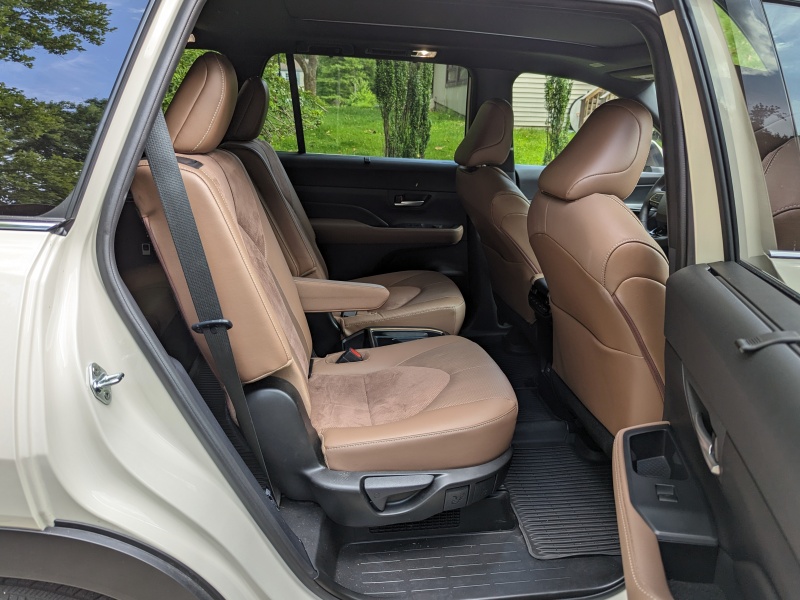
2024 Toyota Grand Highlander Hybrid Max ・ Photo by Brady Holt
Cargo and Utility
It’s a familiar pattern for cargo space: The CX-90 PHEV has a useful amount of room for your belongings, and the Grand Highlander Hybrid simply has more.
By the numbers, Mazda gives you 15 cubic feet behind the third-row seat, 40 cubic feet behind the second row, and 74 cubic feet behind the front seats. That’s below average for a three-row crossover, but especially with the third row folded, the Mazda can still swallow a lot of your stuff. But while the CX-90 has below-average cargo room, the Grand Highlander Hybrid is above average: 20.6 cubic feet behind the third row, 57.9 cubic feet behind the second row, and 97.5 cubic feet behind the front seats. We found the Toyota’s second-row seats awkward to fold down – you need to pull two levers almost simultaneously – but the resulting space is cavernous. Also, while the standard Grand Highlander Hybrid only ties the CX-90 PHEV’s 3,500-pound towing capacity, the Toyota’s more powerful Hybrid Max can tow 5,000 pounds.
Winner: Toyota Grand Highlander Hybrid
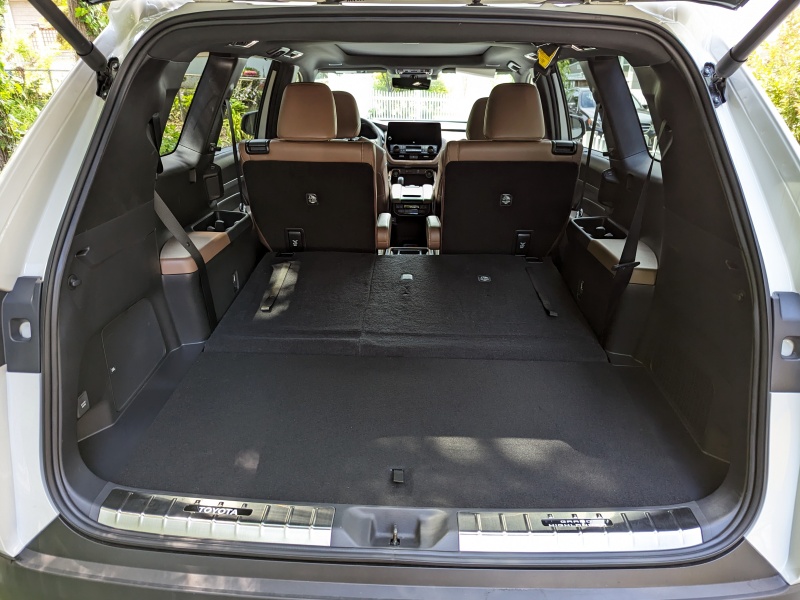
2024 Toyota Grand Highlander Hybrid Max ・ Photo by Brady Holt
Ride and Handling
The Toyota Grand Highlander Hybrid is a perfectly fine crossover to drive. It has a smooth, quiet ride; light, easy steering; and agile handling for its size. In short, it rides and handles like most three-row crossovers.
The Mazda CX-90 PHEV, however, is in a class by itself. It’s solid, stable, and remarkably responsive for a big three-row crossover – on par with the best big European luxury SUVs. The CX-90’s tautly tuned suspension will feel stiffer than the Toyota’s over bumps, and the heavier steering won’t be to everyone’s tastes. But while the Grand Highlander Hybrid has forgettable driving manners, the CX-90 PHEV delivers an experience to remember – while remaining decently comfortable along the way.
Winner: Mazda CX-90 PHEV
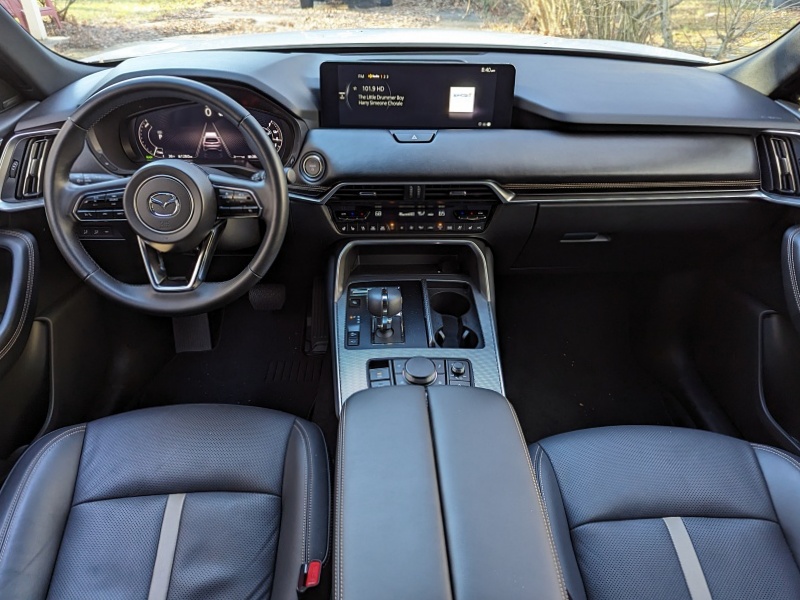
2024 Mazda CX-90 PHEV ・ Photo by Brady Holt
Acceleration
Most Grand Highlander Hybrids pair a 2.5-liter non-turbocharged four-cylinder engine with two electric motors for a combined output of 245 horsepower. That’s essentially the same powertrain you’ll find in a smaller Highlander Hybrid or a Toyota Sienna minivan. We wouldn’t call it slow – it matches the pace of the typical V6 three-row crossover of a decade ago – but it’s no thrill. The 362-hp turbocharged Hybrid Max, meanwhile, is among the quickest crossovers in its segment.
Still, the CX-90 PHEV is just as quick as the Grand Highlander Hybrid Max, and with a richer-sounding engine along the way. It’s also a four-cylinder, and its on-paper output trails the Toyota’s at 319 hp (or 323 hp if you pay up for premium-grade fuel). But instrumented tests show both SUVs needing about 6 seconds to reach 60 mph. And, as we mentioned, the Grand Highlander Hybrid Max costs more than the CX-90 PHEV.
Winner: Mazda CX-90 PHEV
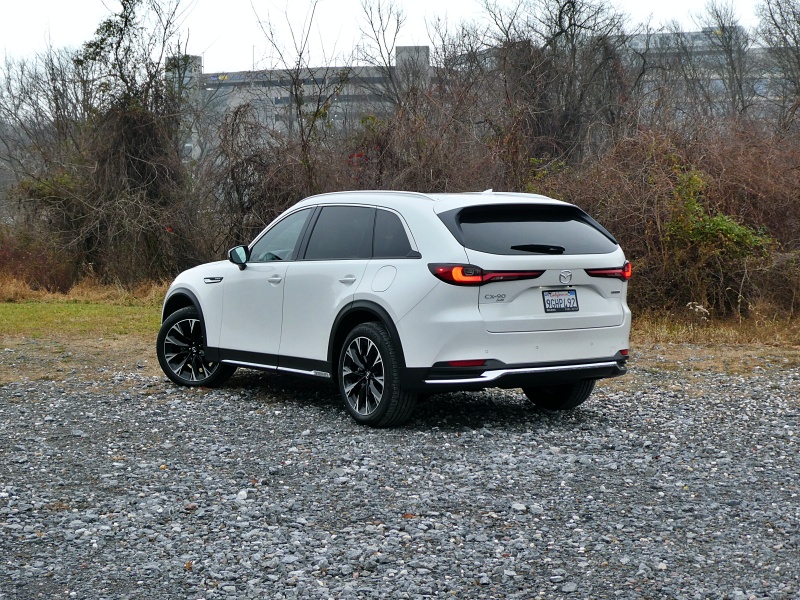
2024 Mazda CX-90 PHEV ・ Photo by Brady Holt
Final Thoughts
Mazda has created a compelling blend of efficiency, performance, luxury, and family-friendly comfort and utility. The 2024 Mazda CX-90 PHEV is great fun to drive, lets you avoid burning gasoline whenever you drive less than 25 miles a day, is beautifully finished and elegantly styled, seats up to eight passengers, and justifies its high starting price with ample performance and a long list of standard equipment. We’re confident that the right buyer will absolutely love owning it.
But the 2024 Toyota Grand Highlander Hybrid strikes us as the better fit for more people. With its base non-turbo powertrain, this eight-seat SUV sips fuel like an economy car while fitting people and cargo almost like a minivan. (While we know that minivans are off-limits for many buyers, we feel obliged to mention that the Toyota Sienna van has more room, the same gas mileage, and a lower price than the Grand Highlander Hybrid.) You don’t get more than short bursts of fully electric range, but you never need to worry about a plug either. And while you don’t go as fast as the Mazda unless you pay big bucks for the less economical Hybrid Max, you have more room inside. If functionality, comfort, and ease of use are your priorities in a three-row hybrid crossover, Toyota’s formula is the winner.
Winner: Toyota Grand Highlander Hybrid
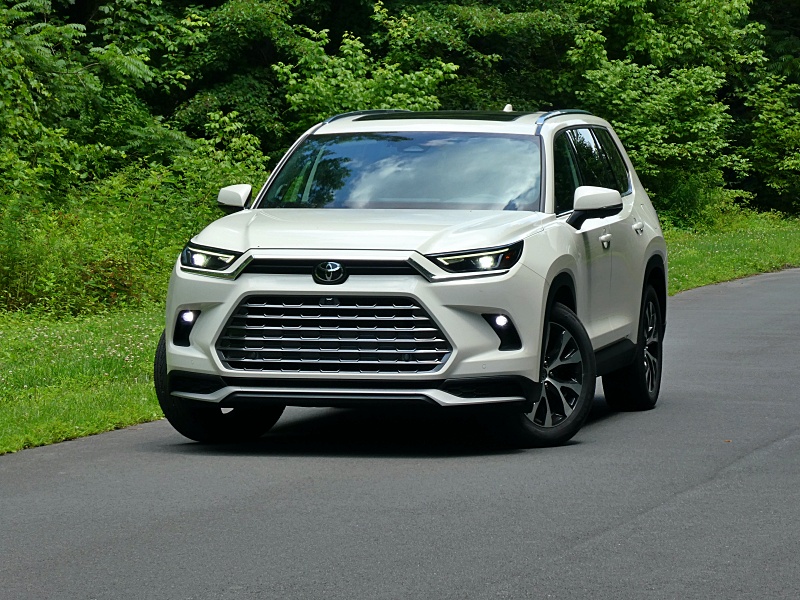
2024 Toyota Grand Highlander Hybrid Max ・ Photo by Brady Holt